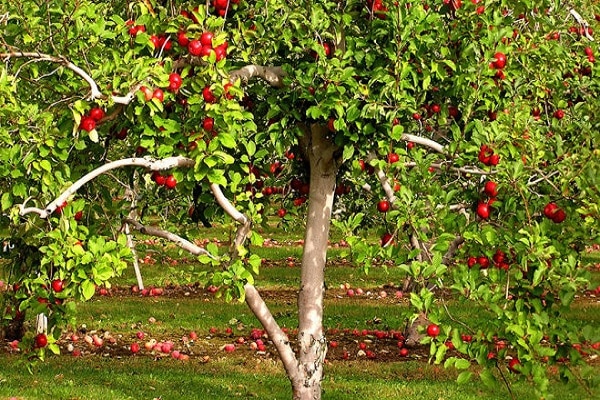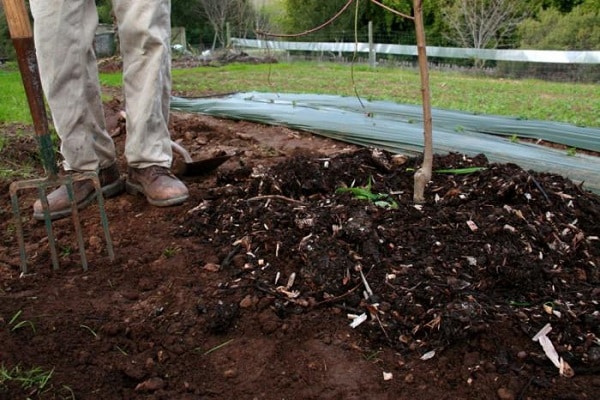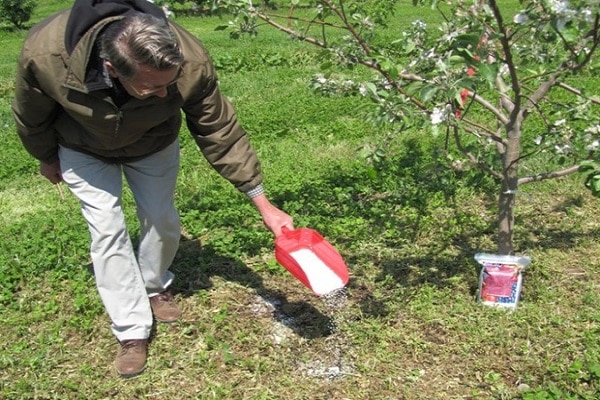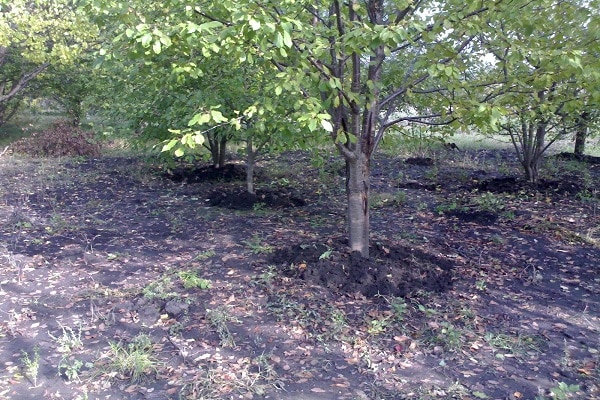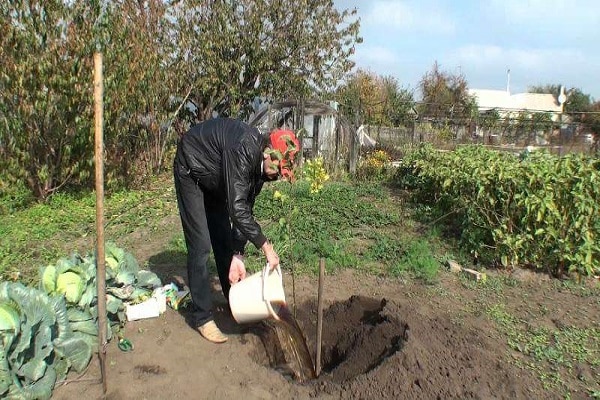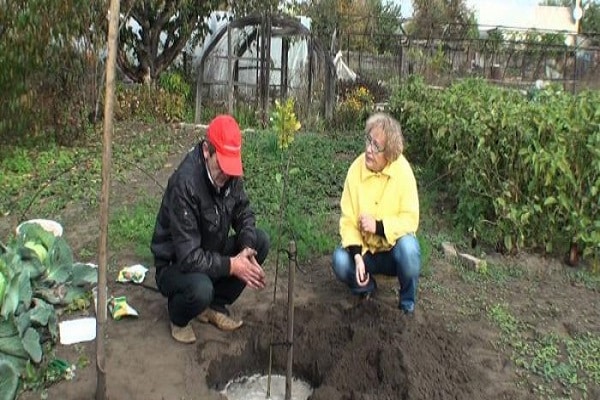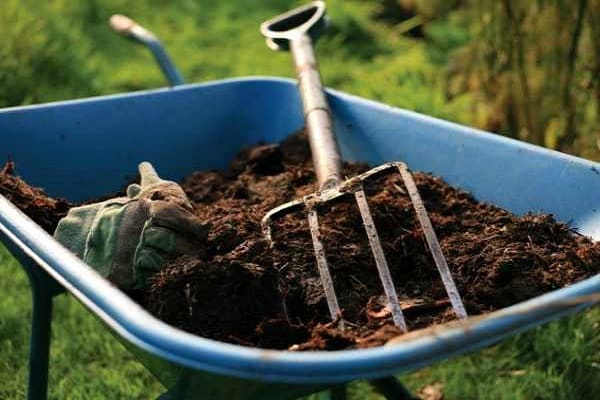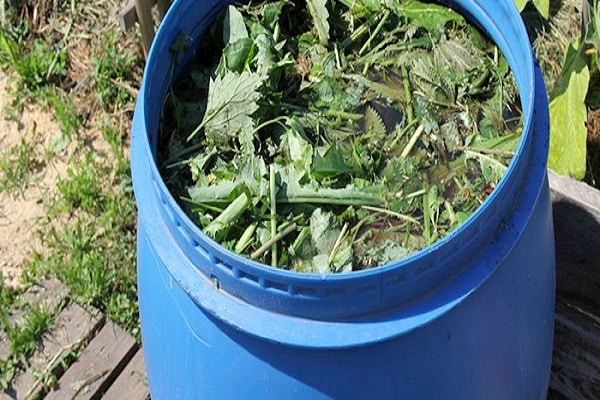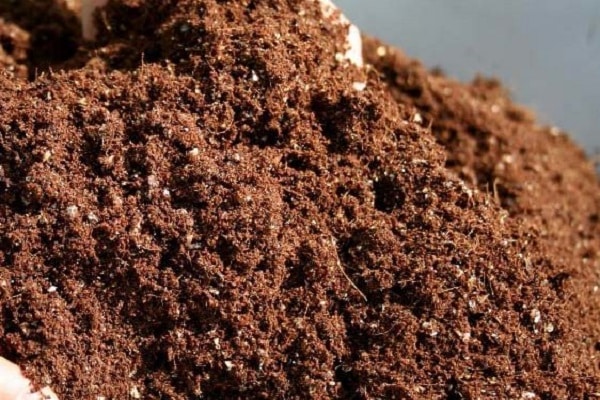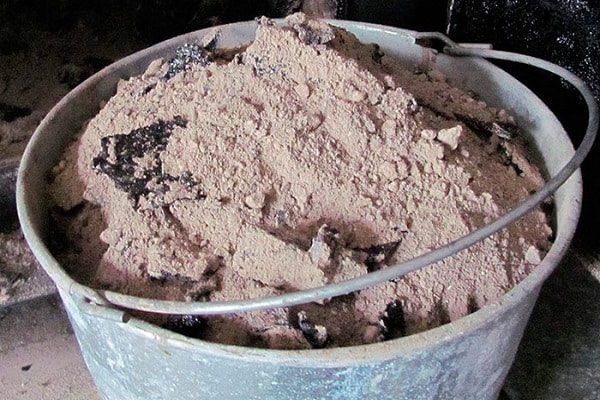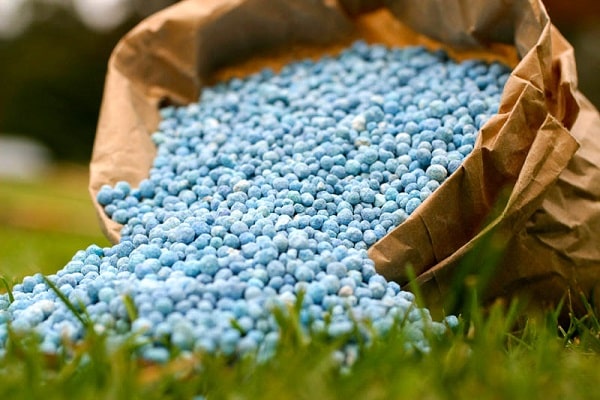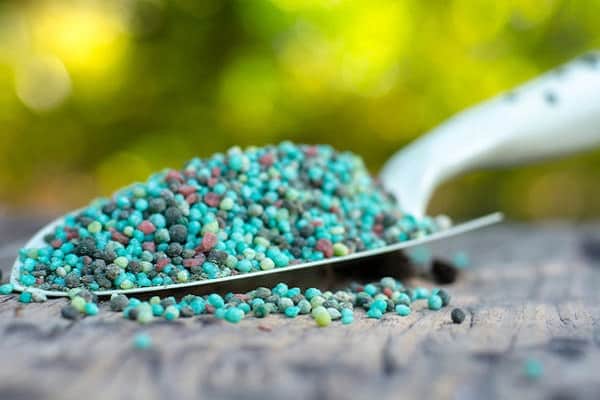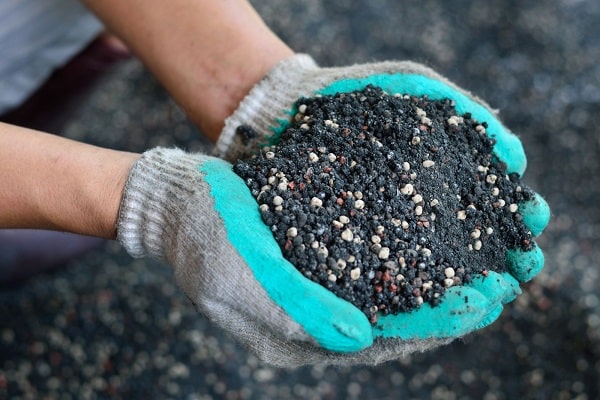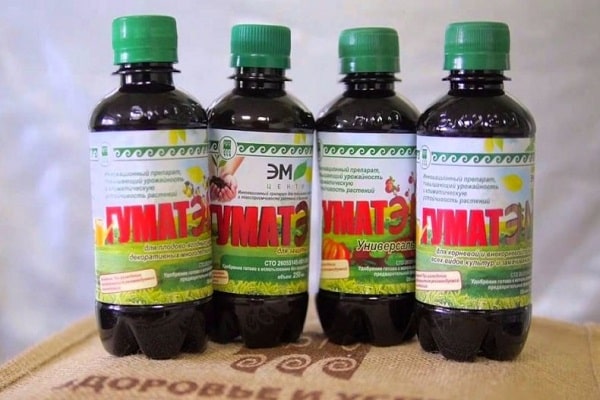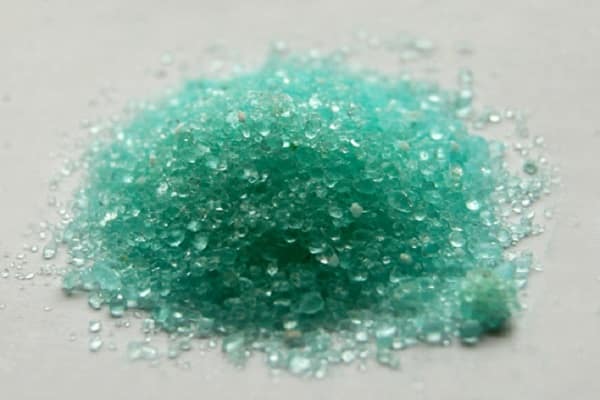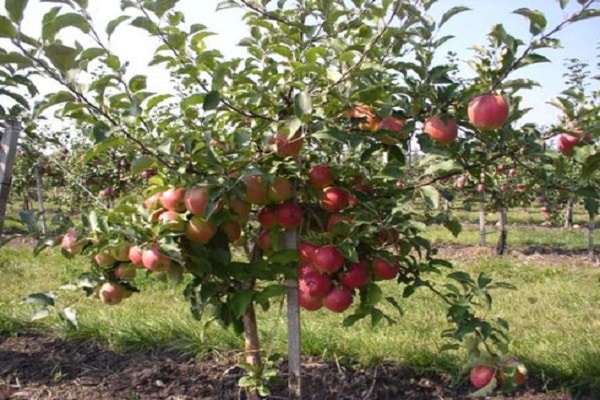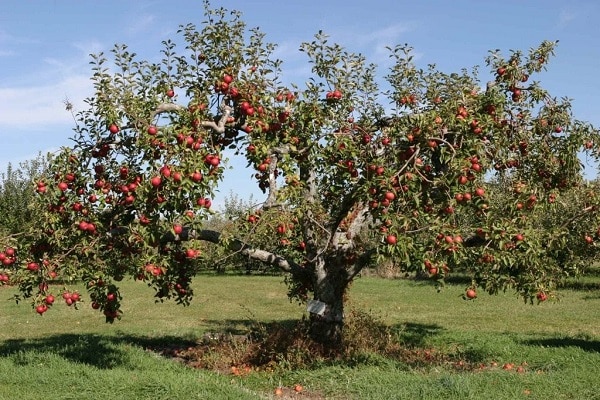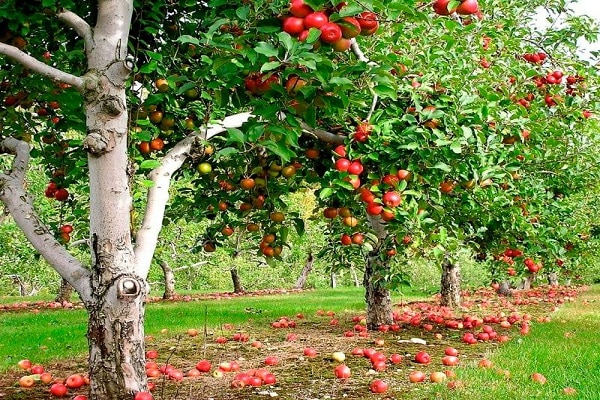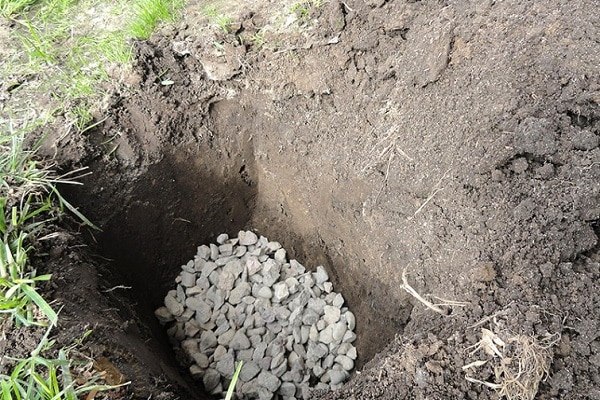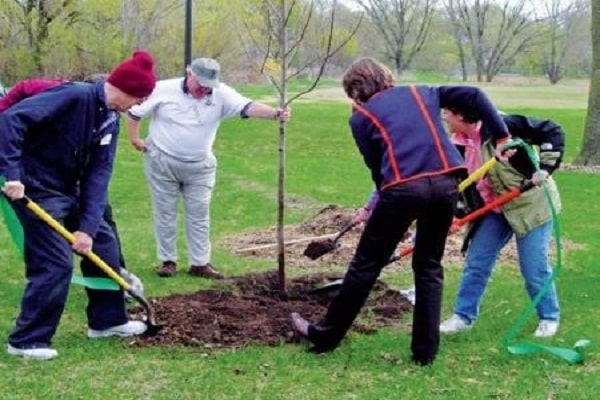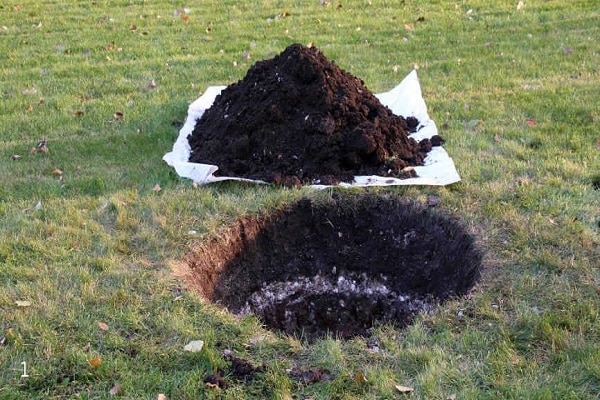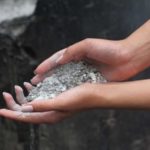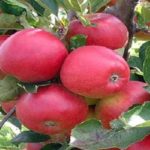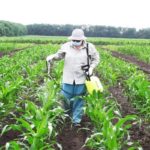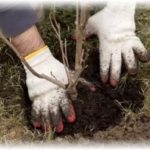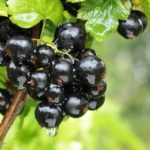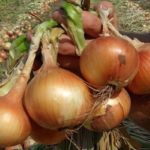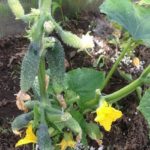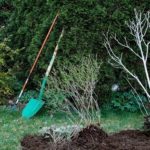The soil under fruit-bearing trees is quickly depleted. The lack of important valuable substances affects the harvest, as well as the health of the plant itself. Apple trees are fed throughout the growing season. Applying fertilizers in the spring helps to recover from hibernation after winter, making them more resistant to possible diseases and pests. Nutrition in summer makes up for the lack of valuable components consumed during the period of development and ripening of fruits. Fertilizers applied in the fall increase resistance to low temperatures and help withstand frosty winters.
- When is the best time to fertilize an apple tree?
- In early spring
- During the summer
- Autumn feeding
- Basic methods of applying fertilizer
- Organic fertilizers for apple trees
- Fresh manure
- Humus
- Boric acid
- Bird droppings
- Wood ash
- Bone flour
- Mineral supplements
- Calcium
- Nitrogen
- Phosphorus
- Saltpeter
- Magnesium
- Potassium
- Sodium humate
- inkstone
- Differences in care for adult and young apple trees
- Fertilizers for the planting hole
- Popular mistakes
When is the best time to fertilize an apple tree?
The apple trees are fed in accordance with the recommended fertilization calendar. The feeding schedule for apple trees has been developed taking into account what microelements it needs, at what time and why.
In early spring
In spring, the earliest feeding is carried out during the period of bud formation and until flowering begins. The indicated time in the middle latitudes falls on the beginning of March, and in the northern latitudes - on the middle of April.
For feeding in spring, it is recommended to choose those fertilizers in which nitrogen predominates; it helps to activate vegetation processes. You only need to use one type of fertilizer for root nutrition: humus - from 2 to 4 buckets per tree, saltpeter - 45 g, urea - 550-650 g.
Important! Fertilizers are not located in the trunk area, but half a meter from it, along the perimeter of the foliage.
In case of excessive application mineral fertilizers the risk of burning the root system of the apple tree increases, which will lead to death. There is no need to add nitrogen to the soil several times. Closer to the time of flowering, the apple tree needs potassium, which stimulates the formation of ovaries.
During the summer
Feeding the apple tree with the onset of summer is considered the second, and is carried out in early June.At the beginning of summer, fertilizers are used to promote the activation of vegetation processes: phosphorus and potassium (for a volume of 10 liters of liquid, 110 g of superphosphate and 75 g of potassium sulfate), dissolved chicken manure, slurry from manure, urea (for a volume of 10 liters of liquid, 110 G).
It is worth considering that granular or powder fertilizers are fed mainly during rainy periods; during dry periods it is recommended to use liquid fertilizers.
In early July, when the fruits acquire the size of an egg, the apple tree is fertilized with a third of nitrogen and a third of potassium fertilizer and a third of phosphorus salt.
Many gardeners claim that at a time when the fruits of late varieties of apple trees are ripening and the early varieties have already been harvested, there is no need for fertilizing. This is not entirely reliable. During this period, new buds are formed, on which the future harvest depends. At the same time, the branches are strengthened, which will allow them to better withstand the winter. Therefore, organic and mineral nutrition during August is also important for apple trees.
Autumn feeding
Fertilizing in autumn is carried out in two stages: in early September and in October. Autumn is the time when apple trees prepare for the upcoming cold weather. They urgently need organic and mineral supplements. It is recommended to use potassium and phosphorus nutrition. Fertilizing with nitrogen is prohibited, as it will reduce the frost resistance of the apple tree. For organic nutrition, humus, compost, and peat are used; the recommended volume for each tree is about 4 buckets. It is allowed to use complex fertilizer.
Nutrition is introduced before winter during the digging process at a distance of half a meter from the trunk, along the perimeter of the foliage. It is allowed to dig holes with a recommended depth of 40 cm.
Basic methods of applying fertilizer
The volume of fertilizer used for fertilizing must comply with the standards developed by agricultural technology. A large number of them, as well as a shortage, will negatively affect the condition of fruit crops: resistance to disease decreases, and productivity decreases.
It is important to understand what type of fertilizer is applied and how. Recommended feeding methods:
- root;
- foliar.
In the first, the necessary valuable components are supplied to the tree trunk area and along the perimeter of the foliage. Hole nutrition is used. But sometimes it becomes ineffective. For example, sufficiently dry soil reduces the digestibility of the nutritional components of fertilizers.
Worth considering! Chemical elements introduced chaotically, without observing deadlines and volumes, will begin to interact and have a negative impact.
The meaning of foliar feeding is to apply it not under the root system, but on the green part of the apple tree, on the area of the leaf plate. Foliage is able to actively absorb and assimilate the most important valuable components. The result becomes obvious after 3-4 days. The effect lasts approximately three weeks. Most often, fertilizing is carried out in cases where the apple tree urgently needs any nutritional components.
The frequency of such nutrition is once every 20-25 days. It is recommended to carry out such feeding at least 2 times a season: the first - during the formation of foliage, the second - during flowering and fruit set.
Rules for foliar feeding:
- The type of fertilizer chosen must be water-soluble.
- For nitrogen nutrition, a 0.3% urea solution is suitable for a young apple tree, and a 0.5% solution for an adult one.
- For phosphorus nutrition - superphosphate. It does not dissolve well, it is recommended to fill it with boiling liquid. You need to bring it to 3% concentration.
- For potassium nutrition - 1% potassium sulfate solution.
- If necessary, it is possible to use complex products; as a rule, they include several extremely important microelements.
Organic fertilizers for apple trees
It is recommended to feed young and fruit-bearing apple trees with fertilizers of organic origin.
Fresh manure
This type of fertilizer has a large number of essential valuable components. It helps improve the soil structure and its physical qualities. It contains a lot of potassium, it is perfectly preserved in the ground, and rains do not wash it away. July feeding is enough to provide the apple tree with the necessary useful components before harvesting the fruit.
It has a significant drawback - the complete absence of phosphorus. This microelement must be provided with other types of fertilizer, for example, bone or fish meal.
Humus
This type of fertilizer includes last year's manure, which has been rotted; it has a large amount of nutritional components. Residues of animal and plant origin, overheating, form humus. Rotted organic matter is not capable of harming the roots. The application rates for fertilizing are the same as for manure.
Boric acid
Fertilization with boric acid is carried out for the purpose of treatment or to prevent deformation and drying of leaves, reddening of the veins.
Bird droppings
Feeding chicken manure is a fairly effective fertilizer; the roots can quickly absorb it. Used as liquid nutrition: 120 g of dry component per 16-17 liters of liquid. Leave for at least 8-10 days. Dry fertilizing is carried out during digging in the spring.
It has a high specific gravity of nitrogen when compared to organic matter from cattle. Given this fact, its use in the fall is extremely limited.In spring, it is also important to comply with application rates; excessive feeding will cause burns to the root system, and young apple trees can be especially affected.
Wood ash
An excellent contrast to phosphorus or potassium fertilizers. It is effectively used to prepare the tree for the winter season. It contains easily digestible substances: copper, boron, potassium, phosphorus, molybdenum, calcium, manganese. There is no chlorine. This is a significant advantage over store-bought analogues.
It is recommended to apply when digging at the rate of 1 kg/m2. It is important to take into account the norms of administration, since it has an alkaline environment and, in excessive quantities, is destructive for microorganisms and earthworms.
Bone flour
You can fertilize a tree with bone meal. It includes, in addition to phosphorus, calcium and potassium. Calcium affects the taste of apples because it takes part in the synthesis of sugar. It is considered a long-lasting fertilizer.
The dissolution period is about 8 months, although it begins to act immediately after application and releases valuable components at regular intervals. Fertilizing is carried out once every three years.
Mineral supplements
This kind of fertilizing is extremely important for plants, but it is important to observe not only the timing of introduction, but also the application rates. It is also worth remembering that some fertilizers of this type are incompatible; they cannot be mixed.
Calcium
Increases the apple tree's resistance to stress, takes part in the transport of auxins to the roots, this helps to activate the development of the root system. Calcium, found in apple juice, promotes the digestibility of nitrogen, mainly urea. Strengthens cell walls, allowing apples to form a mechanical barrier against pathogens.Strengthens the stalks, which prevents unripe fruits from falling off and promotes their ripening.
It is recommended to apply in spring and autumn along with organic matter to a depth of 40 cm around the perimeter of the apple tree. After the leaves appear, apply foliar nutrition according to the instructions so that the apple tree does not get burned.
Nitrogen
Nitrogen ensures the growth of a lush crown. The apple tree receives this element when adding urea. It (another name for urea) is able to dissolve perfectly in liquid and be absorbed very quickly.
There is no need to feed it during the rainy season, the granules quickly decompose, nitrogen will evaporate, and the tree will starve. Administration rates are up to 230 g, the amount depends on the size of the apple tree and its age. It is worth considering that urea acidifies the soil and a large volume exposes the tree to burns. Urea can be replaced with nitrate or ammonium sulfate.
Phosphorus
A very necessary element in the life of an apple tree. Its deficiency affects the flowering and ripening of apples; the foliage turns crimson instead of green. It helps withstand frost and drought. For nutrition the following are used: superphosphate, diammophos, ammophos, bone meal.
Saltpeter
This fertilizer is recognized as one of the most effective nitrogen fertilizations. Used as a root method.
Available in granule or powder form. Promotes growth, increases yield volumes, and improves resistance to harmful factors.
Magnesium
Magnesium is needed to prevent the appearance of gray spots on the foliage and falling from the lower layers of the crown. For this purpose, treatment is carried out with magnesium sulfate.
Potassium
Potassium helps increase productivity, improves the taste of apples, and strengthens the immune system. Potassium chloride or potassium nitrate is used.They actively dissolve in liquid, but penetration into the soil is relatively slow. On soils with a sandy composition, the application dosage is increased.
Potassium sulfate is recognized as a universal fertilizer, containing a huge amount of valuable elements: calcium, magnesium, sulfur and potassium. It promotes the development and growth of apple trees, improves the taste of the fruit.
Feeding is used at any time of the season, but it is mainly recommended to feed in the fall. It is important to evenly distribute the granules over an area of land at a distance of 25 cm from the border of the trunk. They help increase resistance to adverse winter conditions, improve soil fertility and crop quality.
Sodium humate
This fertilizer is used to accelerate fruiting processes and increase the immunity of trees. It also helps get rid of excess nitrites accumulated in fruits. Gardeners believe that it helps fruits ripen faster.
To carry out foliar feeding in the spring, you need to dilute 3 g in 10 liters of liquid. All foliage must be sprayed. The fertilizer includes: nitrogen, potassium, humic acids, phosphorus and other microelements. Spring nutrition promotes strength gain, strengthens the protective properties of the apple tree and increases productivity.
inkstone
Apple trees are highly susceptible to chlorosis; it is characterized by a lack of iron, which results in underdevelopment of the leaf plate and early leaf fall. There is also a decrease in yield due to the underdevelopment of the fruits themselves.
Iron sulfate in solution is effectively used for treatment and for preventive purposes.It can be made at home: add 10-12 g of citric acid to 12 liters of liquid, mix thoroughly until completely dissolved and add 10 g of vitriol. The resulting solution is sprayed on the apple tree in early spring or autumn, when the foliage is shed.
Differences in care for adult and young apple trees
It is important to apply all fertilizers according to the developed standards. There are differences in the types and rates of input of fertilizers. It is worth knowing that the same fertilizer has different input dosages in accordance with the age category of apple trees.
The seedling, first of all, feels a lack phosphate fertilizers, it is important for the growth and strengthening of roots. Within a year after planting, the apple tree does not require additional nutrition, provided that the necessary components were added during planting.
By the 2-3rd year, nutrition is already needed. Attention is paid to fertilizing in the spring; it helps apple trees grow branches and roots. Adding nitrogen alone is not enough; slurry manure will also be insufficient. A complex composition is required: 900 g of bird droppings, 950 g of superphosphate, 750 g of potassium sulfate per 18 liters of liquid. After 2-3 weeks, he recommends foliar feeding.
To ensure high productivity, trees over 10 years old experience a lack of potassium, phosphorus and nitrogen, which is added only in the spring, and potassium and phosphorus during the period of growth and ripening of apples.
During the process of digging and fertilizing, young apple trees are dug in, the recommended depth is up to 20 cm, adults - up to 40 cm.
Feeding the roots of a young apple tree is carried out around the perimeter so as not to burn the trunk.
Apple trees after 10 years of age require special care, since the development process stops, they spend their energy on the processes of regeneration of roots and crowns.A lot of effort is devoted to fruiting.
The trunk circle of a young and mature apple tree is different. In trees after 10 years of age, it is 5-6 m2 in area2.
Fertilizers for the planting hole
In order not to fertilize immediately during the first time after planting, it is important to correctly add the necessary components to the hole. It must be dug and filled accordingly.
It is a mistake to dig a large hole (1 m deep). If fertilizers are placed too deeply, young roots are not able to reach them. Phosphorus also becomes indigestible at depth. Deeply absorbed potash fertilizers, but small roots are not able to reach them.
When planting, you need to dig a hole measuring 50 by 50 cm. At the bottom there is 150-200 g of ash, which can be replaced with 10 g of potash fertilizers. Then add chernozem mixed with 25 g of superphosphate. About 15 cm of the pit remains empty; the main food is placed in this layer.
The soil is mixed with humus in equal proportions. Add complex fertilizer according to the instructions, but during the spring planting period. In the fall, it does not have time to be absorbed, and the presence of nitrogen will damage the tree.
When planting in autumn, complex nutrition is transferred to spring. When loosening, you need to introduce azofoska. You can use manure.
Popular mistakes
When feeding, some gardeners make similar mistakes:
- Fertilizer input rates should not be increased; excess is just as harmful to apple trees as too little.
- During foliar feeding, an overdose of nitrogenous components will burn the crown.
- Foliar feeding is carried out in the morning or in the evening, mainly when it is cloudy.
- Excess potassium interferes with the absorption of magnesium and phosphorus.
Proper fertilizing, consisting of a competent selection of the necessary fertilizers, compliance with the norms and timing of introduction, will provide the gardener with a high-quality harvest and the trees with health.

